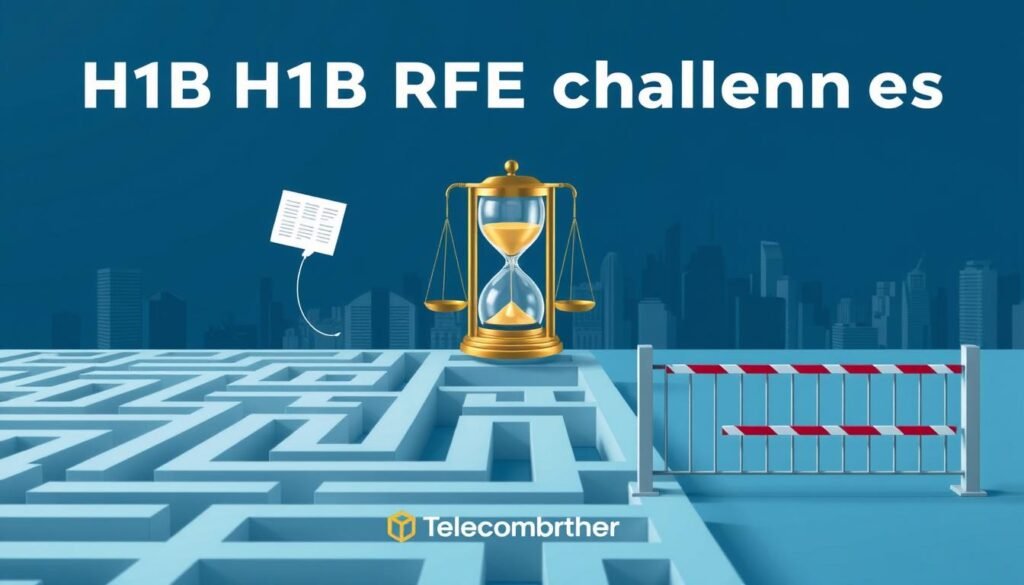Ever wondered why your H1B visa application might get stuck with a Request for Evidence (RFE)? The world of H1B visa requests for evidence is complex. It can be a maze of rules that might stop your professional dreams.
To navigate the H1B RFE process, you need a clear plan and accurate documents. USCIS checks every part of your application, focusing on Curricular Practical Training (CPT) compliance. Showing that your education and work align perfectly is key to getting your visa.
The H1B RFE world is complex. About 30% of H-1B petitions face a Request for Evidence. Knowing the details is vital for international workers wanting to work in the U.S.
Key Takeaways
- Understand the critical role of CPT in H1B visa applications
- Learn how USCIS evaluates practical training documentation
- Recognize common triggers for H1B RFEs
- Prepare comprehensive evidence to support your application
- Know the importance of educational and professional alignment
Understanding H1B RFE
Getting an H1B visa can be tough, and an RFE makes it even more challenging. But, it’s not a no. It’s a chance to make your application stronger and clear up any USCIS worries.
What is an H1B RFE?
An H1B RFE is a letter from USCIS saying they need more info to decide on your visa. It’s a key moment in your application. You get to give more details about your job and why you’re qualified for it.
- Signals additional documentation is required
- Provides an opportunity to clarify application details
- Not a denial, but a request for more evidence
Importance of H1B RFE in Your Application
An H1B RFE is very important. It’s a chance to fix any unclear parts of your application. You can show USCIS all about your job and skills.
“An RFE is your opportunity to tell a complete story about your professional qualifications and job role.”
| RFE Component | Significance |
|---|---|
| Specialty Occupation Proof | Demonstrate job requires specialized knowledge |
| Educational Credentials | Validate degree relevance to proposed position |
| Employer Relationship | Confirm legitimate employment arrangement |
USCIS usually sends an RFE when they’re unsure about your application. It’s key to answer quickly and fully to keep your visa hopes alive. They often ask for more on your job, your employer, and your education.
Knowing how to handle an H1B RFE can really help your chances of getting a visa. Be well-prepared, answer all questions, and provide detailed documents.
Why You Might Receive an H1B RFE
Getting an H1B visa can be tough, and an RFE makes it even harder. Knowing why you might get an RFE helps you prepare better. This way, you can answer their questions more effectively.

The rules for H1B visas are strict. USCIS checks each application closely. About 40% of RFEs are about your education and work experience.
Common Reasons for H1B RFE
- Specialty Occupation Concerns
- About 20-30% of cases get RFEs about job complexity
- USCIS wants to see that the job needs special skills
- Wage Level Scrutiny
- 15-25% of petitions get RFEs about wages
- Employers must explain why they pay what they do
- Third-Party Worksite Arrangements
- 25-35% of cases get RFEs about work setups
- It’s important to show how you work with your employer
Is Your Employment Related to Your Degree?
Your job must match your degree. USCIS checks if your job really needs your degree’s skills.
“The key is demonstrating a clear connection between your education and the proposed job responsibilities.” – USCIS Immigration Guidance
| RFE Category | Percentage of Cases | Key Considerations |
|---|---|---|
| Beneficiary Qualifications | 40% | Verify four-year degree or equivalent |
| Specialty Occupation | 20-30% | Prove job requires specialized knowledge |
| Worksite Arrangements | 25-35% | Document employer-employee relationship |
To boost your chances of getting an H1B RFE approval, show how your education fits your job. Having solid evidence of your qualifications can really help your application.
How to Prepare a Response to an H1B RFE
Getting an H1B RFE can seem daunting, but it’s a chance to improve your visa application. Knowing how to write a detailed response is key to a successful H1B visa application.
- Read the RFE notice carefully
- Find out what specific documents are needed
- Collect all necessary supporting materials
- Write a clear and brief explanation
Gathering Relevant Documents for H1B RFE
When responding to an H1B RFE, you need to collect documents carefully. You’ll need:
- Academic transcripts
- Detailed job descriptions
- Letters from your employer
- Professional certifications
“A detailed response lowers the chance of denial and shows you’re serious about meeting USCIS standards.”
Crafting a Strong Narrative for H1B RFE
Your story should explain why you’re the best fit for the job. Link your education to the job’s needs.
| Document Type | Purpose | Key Details |
|---|---|---|
| Degree Certification | Prove Academic Qualification | Match degree to job requirements |
| Job Description | Demonstrate Specialty Occupation | Highlight complex tasks |
| Employer Letter | Verify Employment Relationship | Confirm role specifics |
You usually have 90 days to answer an H1B RFE. Begin preparing right away for a complete and on-time submission.
Demonstrating CPT Compliance in Your Response
Handling an H1B RFE needs a smart plan, mainly for Curricular Practical Training (CPT) papers. The world of H1B visa requests for evidence is getting more complex. So, making sure you follow CPT rules is key to your application’s success.

Understanding Curricular Practical Training (CPT)
CPT is a big help for F-1 students wanting to get work experience in their field. Here are some important things about CPT:
- It’s a work-study program that fits with your major.
- Some programs need CPT as part of the course.
- It lets students get real-world experience before they finish their degree.
CPT’s Significance in H1B RFE Response
Your H1B employer-employee relationship papers must show a clear link between your studies and your job. Since over 60% of H1B applicants come from colleges, having accurate CPT papers is very important.
Precise CPT documentation can dramatically improve your H1B RFE response success rate.
When you’re answering an H1B RFE, remember these key CPT rules:
- Keep your GPA at least 3.0.
- Make sure CPT is linked to your academic program.
- Give full details of your practical training.
Recent data shows a 98% RFE approval rate for Day 1 CPT students at partner universities. So, having good CPT papers is your best tool in the complex H1B visa world.
Key Documentation to Include for H1B RFE
Handling an H1B RFE needs careful planning and detailed documents. Knowing which papers to include can greatly boost your chances of a positive USCIS response.
Your documents are key evidence of your eligibility for an H1B visa. The right papers can be the difference between approval and rejection.
Academic Transcripts and CPT Authorization
Your academic records are crucial for H1B visa documents. You’ll need to gather:
- Comprehensive academic transcripts
- Official CPT (Curricular Practical Training) authorization letter
- Detailed academic program verification
- Proof of degree relevance to proposed employment
“Documentation is the foundation of a strong H1B RFE response” – USCIS Immigration Expert
Offer Letters and Employment Verification
Your work documents are essential for your H1B evidence. Make sure to collect:
- Detailed job offer letter specifying role and responsibilities
- Employment verification from current or prospective employer
- Comprehensive job description aligned with your academic background
- Proof of employer-employee relationship
USCIS stats show that about 40% of H1B RFEs are about educational qualifications. Your documents must clearly show how your education fits your job.
Remember, well-organized H1B visa documents can greatly help your RFE response. Each document should clearly show your professional skills and job readiness.
Tips for a Successful H1B RFE Response
Handling an H1B RFE can be tough, but with the right steps, you can boost your success chances. Only 26% of applicants got H1B visas this year after an RFE. So, a smart response is key.
When you get an H1B visa RFE, your response must be detailed and thorough. Here are some strategies to help you make a strong H1B evidence requirements response:
Organizing Your Documentation
- Create a clear, logical document index
- Arrange supporting documents in a systematic order
- Include a detailed cover letter explaining each piece of evidence
- Ensure all documents are translated if necessary
Following USCIS Guidelines Precisely
Your H1B RFE response must cover every USCIS point. Key things to remember include:
- Respond within the 90-day window provided
- Provide direct and concise explanations
- Substantiate any discrepancies with clear documentation
- Demonstrate the specialty occupation criteria
“Preparation and precision are your best allies in responding to an H1B RFE.” – Immigration Expert
Important documents often include proof of employer-employee relationship, detailed job descriptions, and educational credentials. These must relate to the specialty occupation. USCIS uses the Validation Instrument for Business Enterprises (VIBE) to check your petition’s information.
RFEs might look scary, but a well-prepared response can greatly improve your approval chances. Spend time carefully answering each requirement and providing detailed, clear evidence of your qualifications.
Seeking Professional Help for H1B RFE
Dealing with H1B visa requests for evidence can be tough. The details of H1B RFE responses need special skills for the best results.
The H1B visa process has grown more complex. In FY 2023, USCIS got 290,689 H-1B petitions. About 10.5% of these got a Request for Evidence.
When to Consult an Immigration Attorney
You might need professional help in these situations:
- Multiple H1B RFE responses needed
- Complicated specialty occupation documents
- Hard to prove employer-employee relationship
- Potential issues with educational qualifications
Benefits of Professional Guidance for H1B RFE
Immigration attorneys offer key support for H1B evidence needs. They can help you:
- Understand complex USCIS rules
- Write strong RFE responses
- Avoid common mistakes
- Boost your approval chances
“Professional guidance can turn a risky H1B RFE response into a well-planned submission.”
With common RFE types like Specialty Occupation, Employer-Employee Relationship, and Beneficiary Qualifications, expert help is crucial.
| RFE Year | RFE Rate | Initial Denials |
|---|---|---|
| FY 2021 | 16.2% | Low |
| FY 2022 | 9.6% | Minimal |
| FY 2023 | 10.5% | 8,844 petitions |
Getting professional help can greatly increase your chances of a successful H1B visa application.
Conclusion: Navigating H1B RFE Successfully
Dealing with an H1B RFE can feel overwhelming. But, understanding the process can greatly improve your chances of success. Approval rates have been high, ranging from 91.4% to 98% in recent years.
Your approach to the H1B evidence requirements is very important. USCIS gives you 90 days to respond. This time allows you to gather all needed documents and write a strong narrative. About 60% of H-1B petitions with an RFE are approved if handled well.
Preparation is crucial for handling an H1B RFE. Make sure you have all the right documents and address any concerns early on. If your case seems complex, getting professional help is a good idea. The best applicants see an RFE as a chance to improve their application, not a problem.
Your hard work can turn an RFE into a step towards your professional goals in the U.S. Stay organized, answer fully, and keep a positive attitude during the process.

